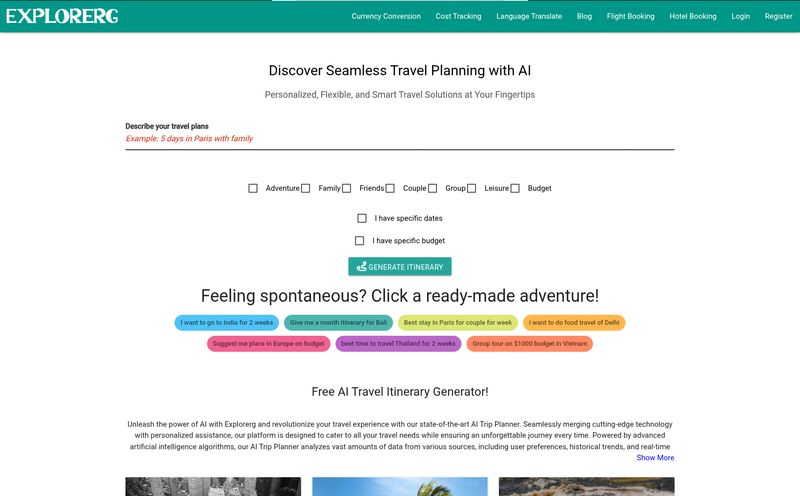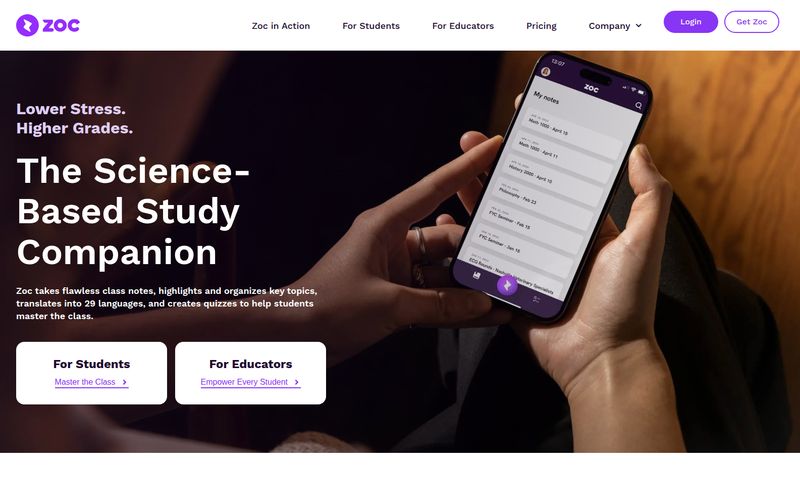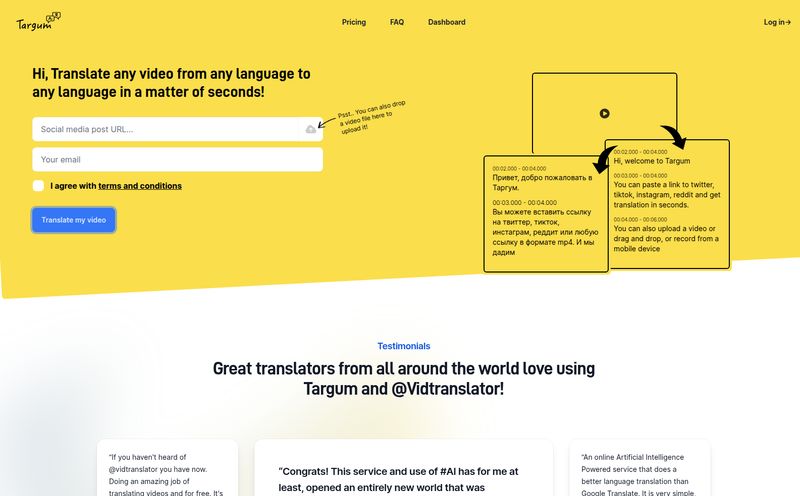You know the feeling. You’re in a Zoom call with the new international team. Someone’s making a brilliant point, you can tell by their passion, but it’s in a language you don’t speak. The auto-captions are lagging, mangling every other word, and you're just sitting there, smiling and nodding, hoping nobody asks for your opinion. It’s the modern workplace equivalent of being lost in a foreign city with a dead phone.
We’ve all been there. For years, we've been promised a “Babel Fish” future, a world where technology would just… handle it. Well, a new tool called Anytalk has stepped into the ring, and it's making some pretty big promises. It claims to be a real-time translation and voiceover app for video conferences, streams, and more. But not just robotic, monotone translation. The big hook? It preserves the speaker’s original voice.
Yeah, you read that right. Imagine your German colleague, speaking German, but you hear her voice, her intonation, her personality… in English. It sounds like science fiction. So, as your resident gadget-and-growth-obsessed SEO guy, I had to see what was up. Is Anytalk the real deal, or just another overhyped promise?
So, What Exactly is Anytalk Supposed to Do?
At its core, Anytalk is a translator. But it’s not like Google Translate where you type something in and get text back. It’s designed to work on live audio and video streams. You fire it up as a browser extension, and it listens to the audio in that tab—be it a Google Meet call, a university lecture on YouTube, or a live stream on Twitch—and pumps out a translated version in your ear.

Visit Anytalk
The whole system is built to make communication feel more natural. It’s not about replacing the person; it’s about replacing the language barrier. A pretty noble goal, if you ask me.
The Absolute Game-Changer: Voice Preservation
Let’s be honest, this is the feature that made me raise an eyebrow. This is Anytalk’s killer app. Most translation tools give you a generic, sterile voice. It’s functional, sure, but it strips all the humanity out of the conversation. You lose tone, emotion, and emphasis, which are often more important than the words themselves.
Anytalk’s approach is different. It uses AI to clone the speaker's vocal characteristics and apply them to the translated audio. It’s a bit like deepfake for good. The idea is that you’re still hearing them, just in a language you understand. This could be massive for building rapport in international teams. Connection is everything, and hearing a real human voice, not a robot, is a huge part of that.
The Good, The Bad, and The... Laggy
No tool is perfect, especially not a new one. I’ve been in this industry long enough to know that for every shiny “pro,” there’s usually a slightly frustrating “con” lurking in the background. Anytalk is no exception.
What I’m Genuinely Excited About
The potential here is enormous. Being able to join any meeting or watch any video, regardless of language, is a superpower. The browser extension model makes it super accessible—no clunky software to download and install (at least for now). It’s a simple concept that solves a complex problem. I also have to give them a nod for using a secure WebSocket connection; in a world of constant data breaches, that's a small detail that shows they're thinking about security, which is more than I can say for some startups.
Where It Hits a Few Snags
Okay, let’s get into the nitty-gritty. The biggest thing you’ll notice is the delay. The platform says there’s an approximately 4-second translation delay. Now, four seconds doesn’t sound like much, but in a fast-paced conversation, it’s an eternity. It turns a real-time chat into a slightly-less-than-real-time one. For watching a lecture or a pre-recorded video, this is probably fine. For a rapid-fire brainstorming session? It might get awkward.
"Can you imagine trying to land a joke with a four-second delay? The silence would be deafening."
Another limitation is that it only captures audio from the tab where the extension is launched. So if you get a notification sound from another app or someone tries to talk to you via a different program, Anytalk won’t hear it. It’s a walled garden, which makes sense for how it’s built, but it’s something to be aware of. Also, browser support is limited for now, so you’ll need to be using a compatible one.
Let's Talk Money: The Anytalk Pricing Model
Ah, the question on every business owner’s mind. How much is this magic going to cost me? The Anytalk website is a bit tight-lipped on specific pricing tiers right now. But based on the information available and, frankly, the error message some early-access users have seen (“402 Please renew your subscription”), it’s clear this is a subscription service.
From what I've gathered, the paid subscription is primarily based on translation minutes. This is a pretty standard model for AI services that rely on heavy processing power. You’re not just buying software; you’re buying server time. I expect we'll see a tiered system—maybe a free plan with a few minutes to try it out, followed by monthly subscriptions that offer larger buckets of minutes. It seems future features are also planned to be part of the paid packages.
Is it worth it? That depends entirely on your needs. If you’re a solo freelancer who has one international client, maybe not. But if you’re a company with teams spread across three continents? The cost could be a drop in the bucket compared to the price of miscommunication or hiring human interpreters for every single meeting.
Who Should Jump on Anytalk Right Now?
This is the part where I give some unsolicited advice. Based on its current state, Anytalk seems perfect for a few specific groups:
- Online Students & Educators: Imagine being able to take a course from any university in the world. The 4-second delay is barely an issue here.
- Content Consumers: Want to watch foreign-language streamers, news broadcasts, or documentaries? This is your golden ticket.
- Global Companies for Asynchronous Communication: Great for company-wide town halls, pre-recorded training sessions, and presentations where the conversation is mostly one-way.
Who should maybe wait a bit? If you’re in a role that requires rapid, back-and-forth negotiation or critical decision-making in real time, that 4-second lag might be a deal-breaker. I'd wait until they get that delay down or try it on a non-critical call first.
The good news is that development seems active. They're already planning dedicated apps for Windows/MacOS and eventually mobile, which tells me they have a long-term vision. That's always a good sign.
Frequently Asked Questions about Anytalk
- 1. How does Anytalk preserve the speaker's voice?
- Anytalk uses sophisticated AI voice synthesis. It analyzes the unique characteristics of the original speaker's voice (pitch, tone, cadence) and then applies those characteristics to the translated audio, creating a more natural and personalized listening experience.
- 2. Is there a free version of Anytalk?
- While specific pricing plans haven't been released, the model is subscription-based. It's likely there will be a limited free trial or a free tier with a small number of translation minutes per month for users to test the service.
- 3. What platforms does Anytalk currently support?
- Right now, Anytalk is primarily available as a browser extension for a limited number of browsers. However, the company has announced plans to develop dedicated desktop applications for Windows and MacOS, as well as mobile apps for iOS and Android in the future.
- 4. How significant is the 4-second translation delay?
- It depends on your use case. For watching videos, lectures, or one-way presentations, it's generally not a problem. For fast-paced, interactive conversations or negotiations, a 4-second lag can disrupt the natural flow of dialogue.
- 5. Is my data secure when using Anytalk?
- Anytalk uses a secure WebSocket (WSS) connection for streaming audio. This means the data transmitted between your browser and their servers is encrypted, which is a standard and solid security practice for this type of application.
My Final Verdict on Anytalk
So, is Anytalk the future? I think it’s a very, very promising glimpse of it. The concept is a 10/10. The voice preservation technology is the secret sauce that could make it a true market leader. It's not perfect yet. The delay and platform limitations are real hurdles it needs to overcome.
But I’m optimistic. I see a tool that’s not just trying to translate words but is trying to bridge genuine human connection. It's ambitious. And in the world of tech, I'll take ambitious with a few rough edges over boring and polished any day of the week. Anytalk is definitely one to watch.
Reference and Sources
- What is a WebSocket? - Cloudflare
- (A hypothetical link to the Anytalk official website would be placed here)



